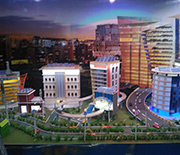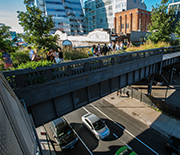News Release 18-004
New, forward-looking report outlines research path to sustainable urban systems
NSF advisory committee assesses ongoing transformation of our increasingly urban planet

Sustainable cities report by NSF's Advisory Committee for Environmental Research and Education.
January 17, 2018
This material is available primarily for archival purposes. Telephone numbers or other contact information may be out of date; please see current contact information at media contacts.
Find related stories on NSF's Environmental Research and Education (ERE) programs at this link.
In 1950, fewer than one-third of the world's people lived in cities. Today more than half do. By 2050, urban areas will be home to some two-thirds of Earth's human population.
"This scale and pace of urbanization has never been seen in human history," states a new report, Sustainable Urban Systems: Articulating a Long-Term Convergence Research Agenda.
The document was authored by members of the National Science Foundation (NSF) Advisory Committee for Environmental Research and Education's (AC-ERE) Sustainable Urban Systems Subcommittee, chaired by bioproducts and biosystems engineer and public affairs professor Anu Ramaswami of the Humphrey School of Public Affairs and the College of Food, Agricultural, and Natural Sciences at the University of Minnesota. It serves as a guide for the direction research on cities might take today and in the future.
We live on an urban planet, according to the AC-ERE report, one where cities, although occupying only 3 to 4 percent of Earth's land surface, are affecting human and environmental well-being on scales from the local to the global.
The goal of sustainable urban systems
How will we reach the goal of sustainable urban systems? "The AC-ERE report is an excellent foundation for new scientific collaborations on how cities function, how they grow, and how they can be managed sustainably for decades to come," says Earth and environment scientist Tony Janetos of Boston University, and chair of the AC-ERE.
To develop the next generation of sustainable urban systems research, states the report, "a much broader and longer-term research agenda is needed."
Adds Leah Nichols, chair of NSF's Working Group on Environmental Research and Education, "Current and past NSF investments have created a strong foundation for the research agenda outlined in the report. Programs such as Innovations at the Nexus of Food, Energy and Water Systems; Smart and Connected Communities; and Science, Engineering and Education for Sustainability have supported interdisciplinary projects with far-reaching results."
The time is now
Changing urban areas "present a historic opportunity to improve human and environmental well-being, locally and globally," states the AC-ERE report.
"Researchers, industry leaders and policymakers are recognizing a time-sensitive opportunity to develop a new convergence science of sustainable urban systems that's multi-scale, trans-disciplinary, and advances science-policy-community partnerships to identify pathways toward a more sustainable urban future."
Cities: double-edged swords
Few challenges are more compelling than how to make cities sustainable, say AC-ERE members.
In the U.S., urban areas are home to some 80 percent of the country's human population and generate 85 percent of the Gross Domestic Product, making them critical for local and national prosperity, security and well-being, the report states.
While cities and their suburbs are engines of innovation, they also face issues such as aging and inadequate infrastructure; human health risks from pollution, poor diets and sedentary lifestyles; vulnerability to disasters and extreme events, such as hurricanes Harvey, Irma, and Maria and California's recent wildfires; and inequities in economic opportunity.
'Transboundary flows' from cities
Complicating the picture, what happens in a city doesn't stay in a city.
Transboundary flows of people, natural resources, and goods and services, as well as waste and pollution, move from place to place via networks of trade, infrastructure and information. The effects extend well beyond urban boundaries, states the AC-ERE report.
Energy use in cities contributes to more than 70 percent of global greenhouse gas emissions. Water supply to just 50 percent of the world's largest urban areas draws on watersheds covering a large part of Earth's land surface: 41 percent.
Regional air pollution from cities is a factor in more than 6.5 million premature deaths each year worldwide. Water stress and weather extremes, such as heat, cold and floods, affect human lives and economies in cities from Bangkok to New York, Phoenix to Chicago. And the regions around them.
No city is an island.
Advancing next-generation sustainable urban systems science
Scientists need new data, methods and theories that assess the interactions among people, technology, infrastructure and natural systems to understand how cities function and change, according to the AC-ERE report.
Next-generation urban systems science requires that researchers study urban areas in ways that connect homes, businesses and communities to impacts on regional and global scales, the report's authors believe.
Scientists need to look for commonalities across metropolitan areas that would help cities learn from each other, states the document. And researchers need to work with community members, city managers, local government officials, and industry representatives to produce knowledge that's practical and useful.
Specific questions the report cites: How will innovation and new technologies, such as self-driving electric vehicles, transform cities? How do we make cities more secure, disaster-resilient and healthy?
Our collective future depends on finding answers. We need to know, say the members of the AC-ERE, how to handle life on a planet that's becoming more and more urbanized. Whether we're ready or not, the challenge is here.
-NSF-
-
A view of Seattle today, a city working toward becoming a sustainable urban system.
Credit and Larger Version -
What will a future sustainable city look like? Pictured here is one artist's conception.
Credit and Larger Version -
An urban forest along New York City's elevated High Line.
Credit and Larger Version -
Residents of Chicago tend urban farms planted between city buildings.
Credit and Larger Version -
Members of a community in California's Silicon Valley plan for a sustainable future.
Credit and Larger Version
Media Contacts
Cheryl Dybas, NSF, (703) 292-7734, email: cdybas@nsf.gov
Related Websites
NSF News: New report addresses current and future environmental research, education needs: https://nsf.gov/news/news_summ.jsp?cntn_id=136041&org=NSF
NSF News: New report on transitions and tipping points in complex environmental systems: https://www.nsf.gov/news/news_summ.jsp?cntn_id=115474
NSF Discovery Article Series: Environmental Research and Education: https://www.nsf.gov/news/newsmedia/ENV-discoveries/ERE-discovery-series.jsp
The U.S. National Science Foundation propels the nation forward by advancing fundamental research in all fields of science and engineering. NSF supports research and people by providing facilities, instruments and funding to support their ingenuity and sustain the U.S. as a global leader in research and innovation. With a fiscal year 2023 budget of $9.5 billion, NSF funds reach all 50 states through grants to nearly 2,000 colleges, universities and institutions. Each year, NSF receives more than 40,000 competitive proposals and makes about 11,000 new awards. Those awards include support for cooperative research with industry, Arctic and Antarctic research and operations, and U.S. participation in international scientific efforts.
Connect with us online
NSF website: nsf.gov
NSF News: nsf.gov/news
For News Media: nsf.gov/news/newsroom
Statistics: nsf.gov/statistics/
Awards database: nsf.gov/awardsearch/
Follow us on social
Twitter: twitter.com/NSF
Facebook: facebook.com/US.NSF
Instagram: instagram.com/nsfgov




